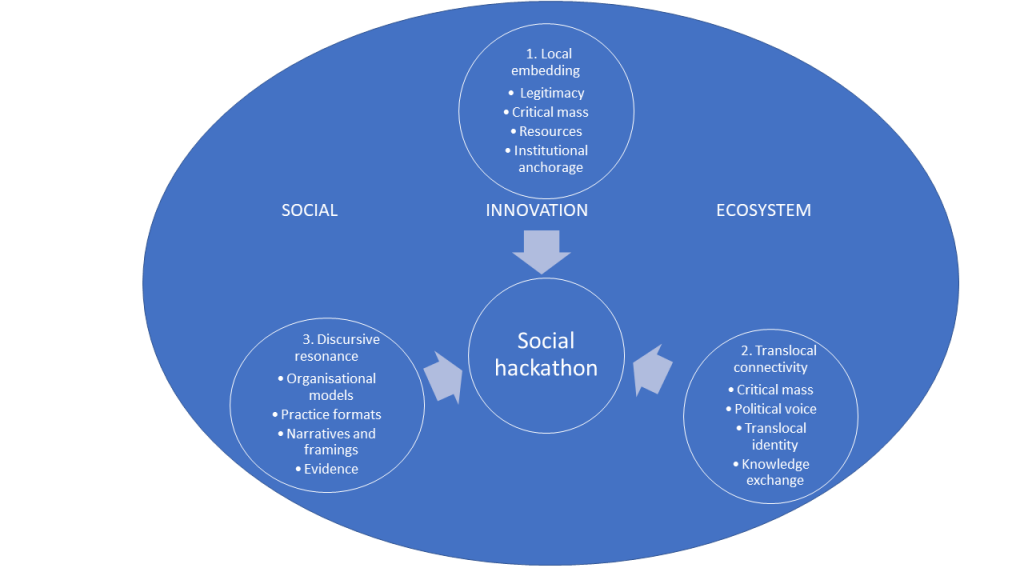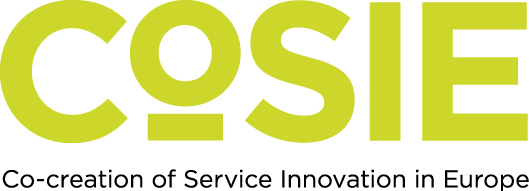Not Hacked off at All

In August 2020, organisers of the Estonian social hackathon “Vunki mano” asked me to contribute to the event, this time as a jury member. I had been to the three previous events – as a mentor, an interviewer of the participants and panellists, and as a supervisor of a student team participating in co-creation. As I had seen the evolution and progress of the event and enjoyed it every time, I was delighted to take part. I couldn’t let go of my academic suspicions… It is easy to criticise ideas and teams, but do we actually have the right metrics in place for doing it?
This brings me to the discussion of social impact and evaluation of social innovation.
We, as the jury, were asked to assess the single ideas and teams based on the final pitches. In our discussion we focused on the following criteria:
– The importance of the topic for the development of Võru County where the hackathon takes place
– The functionality and effectiveness of solutions
– The stakeholder involvement in co-creation and implementation
– The capacity of the team to implement the idea
– The contribution of the solution to peoples’ wellbeing and welfare.
On the one hand, these criteria were helpful in choosing the winning team, who hacked how to prevent the local Võru language from fading away. We know that social innovation is contextual (Mulgan, 2019), and preservation of the local identity as the basis for sustainabilty and progress are well justified and clear to the wider members of the public. On the other hand, they left us wondering about another team with a clear business model and a sales focus on a larger scale. Potentially, the realisation of the idea could bring many jobs to the county but the core idea was to sell a product, and we were there to evaluate social innovation ideas instead of prototypes. Hence, the metrics and impact assessment is far from being straightforward!
According to good academic traditions, I could add more layers of complexity to that evaluator’s task. We have also been asking ourselves in the process and among outside observers if the social hackathon is a feasible co-creation approach for facilitating innovation in local public services. This issue triggers another task – we should be looking at the social innovation ecosystem around the hackathons to analyse what support it could bring for emergence and nurture of local innovative ideas. The SI ecosystems exist in many forms but they tend to consist of a “multitude of actors and organizations that co-shape social innovations” (Pel et al 2019). Pel et al argue that “SI ecosystems can be seen to rely on three essential kinds of empowering network constellations” which are “local embedding, trans-local connectivity and discursive resonance”.
Let’s look next at what we could say about the SI ecosystem in Võru county based on that framework.

Local embedding
The local fertile ideas find their place to grow in the hackathon which forms the platform for the SI to flourish. The hackathon organisers have intensively introduced the concept of Vunkimano in the local community and amongst the policy makers, thus empowering the process by legitimacy. As illustrated above, the clear focus is on local needs. Based on the experiences in the four hackathons, it can be said that the ideas have grown in magnitude and importance for the wider region (e.g. from a transport problem of a village mother to an issue of the disappearance of the identity of Võru). The critical mass of followers and active participants has grown from one event to the next. The hackathons provide the participants with material resources from the tools and canvases up to food and accommodation. They have developed into co-creation demonstration environments, where co-creation is trained in favourable conditions including the relevant resources, such as stakeholders, knowledge, design tools, funding for development. And lastly, the sustainability of the hackathon presupposes the institutional anchorage which has been achieved by gaining political agreements of SI advancement in e.g. development plans.
Trans-local connectivity
It is manifested through “empowerment processes such as (a) the development of trans-local “critical mass”; (b) the construction of trans-local political voice; (c) the development of trans-local collective identity (as materialized in brands and logos), and (d) knowledge exchange”. The attempts for trans-local connectivity have been made after gaining experiences from the number of events. Together with Tallinn University, the Võru Development Centre has participated in the development project of the Hungarian Association for Community Development, helping them to organize similar social hackathon events in Hungary and in Transylvania (Romania). The events are being replicated elsewhere in Estonia and the knowledge shared on the methodology of promoting SI. Vunki Mano has been established as a brand on the local level but attempts are made to scale up the brand. A visual example of ths was omitting Võru County from the website domain name and keeping it as www.vunkimano.ee
Discursive Resonance
Discursive resonance is a “collective process that involves the whole communicative sphere through which socially innovative concepts gain political and scientific authority” .
It is typically manifested through “the circulation of (a) organizational models; (b) formats of practices; (c) framings and narratives and (d) codified knowledge on
socially innovative concepts and practices” (Pel et al 2019). Several social innovation (SI) ideas of the last hackathon resonate with the current political and civil society discourses e.g. the idea of co-creating a better school or involvement of youngsters in providing safe communities. The communication infrastructures, such as the website and social media channels for spreading SI ideas are being used by promoting the hackathon itself. In terms of the work modes and formats, co-creation is experimented with the representatives of all sectors. The several science-based efforts around the hackathon and publications of articles aim at creating resonance among the academic communities and beyond.
Based on the crash course of the SI ecosystem analyses in Võru County, the preliminary evidence shows that empowerment through all the three means is taking place. This advancement of the social innovation ecosystem also resonates in the SI ideas that the jury had to evaluate. The relevance for the whole community and the scope are only growing ….hence, the impact can only get better.
Writer: Katri-Liis Lepik, PhD, Tallinn University
References:
Pel,B., Wittmayer, J., Dorland, J. and Jørgensen, M.S. (2019): Unpacking the social innovation ecosystem: an empirically grounded typology of empowering network constellations, Innovation: The European Journal of Social Science Research, DOI: 10.1080/13511610.2019.1705147
Mulgan, Geoff (2019) Social Innovation. How Societies Find the Power to Change. Policy Press. Bristol, UK
